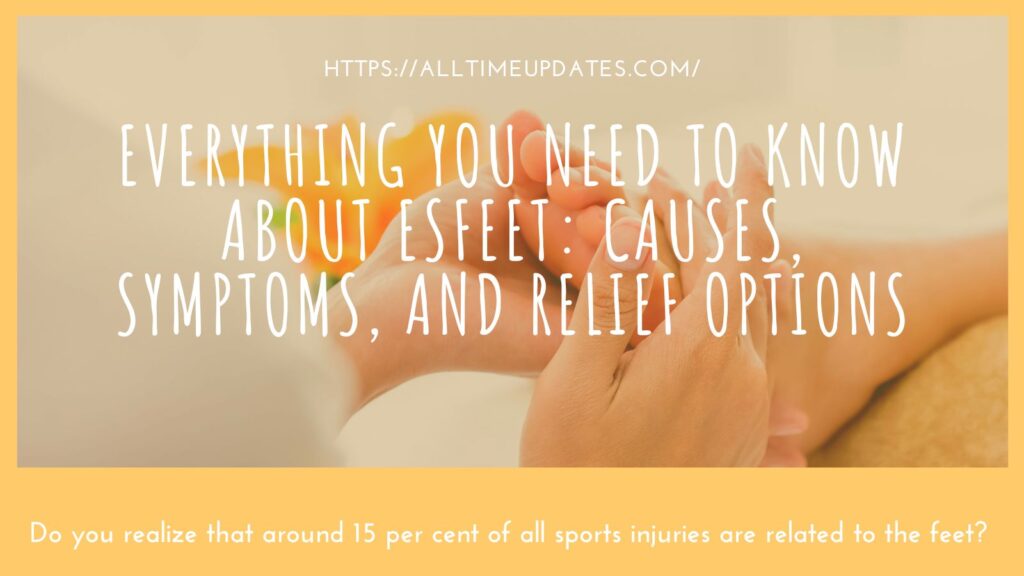Do you realize that around 15 per cent of all sports injuries are related to the feet? This shocking statistic reveals an often misunderstood problem affecting athletes and all populations participating in routine sporting activities. In scientific terms, feet co, mainly known as plantar fasciitis, is defined by irritation of the thick layer of connective tissue running across the foot’s sole that connects the heel bone with your toes.
Its widespread presence among competent runners and casual exercisers makes understanding the condition vital to ensure fitness and physical wellbeing. This guide is a comprehensive look into the world of feet and explains its causes, symptoms, different treatment options, and practical strategies for prevention to keep you in good shape and pain-free.
What Is Esfeet?

Esfeet relates to a particular area of foot health, with medical care focused on the overall health and care of feet. Although it is not an often-used phrase, it covers strategies to ensure good foot health together with various techniques, including good hygiene, routine examinations and treatment for ailments that range from minor ailments such as calluses and bunions to more complicated conditions like plantar fasciitis and diabetic neuropathy. Esfeets are vital for those who require specific foot health care, including those who are elderly, athletes, or people with diabetes.
Types Of Esfeet
The seats available differ based on the requirements and the conditions being addressed. They can comprise:
- Preventative Esfeet: This program ensures foot health through proper footwear use, hygiene, and regular checks to avoid foot issues.
- Therapeutic Esfeet: focuses on treating current foot problems with different methods, such as medication, physical Therapy, or surgical procedures.
- Cosmetic Esfeet: Enhances the look of your feet by addressing problems like the appearance of nail discolouration or scars, as well as other minor issues.
Anatomy Of The Foot
Understanding your foot’s structure and function is integral to understanding its significance in our bodies. Each foot comprises 33 bones connected by 26 joints connected via ligaments. Furthermore, more than 100 muscles, tendons and ligaments bind them together, forming an intricate network. It’s divided into three components:
- The forefoot comprises five toes (phalanges) and connective bone (metatarsals).
- The midfoot is a pyramid-like group of bones that forms the arches of the feet.
- Hindfoot The hindfoot connects your ankle, consisting of your heel (calcaneus) and ankle bones (talus).
By understanding the effect, people can appreciate the significance of caring for feet and the impact of various foot problems on general wellbeing and mobility.
Causes Of Esfeet
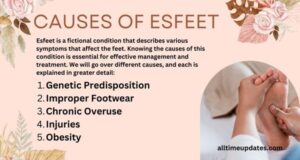
Esfeet is a fictional condition that describes various symptoms that affect the feet. Knowing the causes of this condition is essential for effective management and treatment. We will go over different causes, and each is explained in greater detail:
- Genetic Predisposition:
-
-
- Description: Genetics may significantly impact foot formation. People with relatives with similar conditions to those affecting feet may be more prone.
- Illustration: A diagram showing genes that transmit could favour insight into how the effect gene could be inherited.
- Sources: Research papers from medical journals specializing in paediatrics or genetics could favour solid evidence.
-
- Improper Footwear:
-
-
- Description: Wearing footwear that doesn’t fit properly or provides insufficient support may result in structural foot problems. Shoes with narrow toes and high heels tend to be the culprits.
- Illustration: the various kinds of footwear and their effects on foot shape can be helpful.
- Sources: The suggestions of organizations for podiatrists on the right shoes could be a reliable source of recommendations.
-
- Chronic Overuse:
-
-
- Description: Repetitive stress to feet from sports like dancing, running, or prolonged periods can trigger or worsen foot symptoms.
- Illustration: Diagram that illustrates the points of stress in the foot during different tasks.
- Sources: Research studies from medical journals on sports detailing the effect of repeated stresses on the foot’s health.
-
- Injuries:
-
-
- Description: Chronic or acute foot injuries could lead to chronic complications such as feet. Fractures, sprains and tendonitis are all typical instances.
- Illustration: A picture or series of images illustrating a typical foot injury.
- Sources: Case studies of clinical patients in orthopaedic journals may favour clues into how injuries cause ESFeet.
-
- Obesity:
-
- Description: The body’s weight can increase the strain and stress on the feet, possibly leading to or aggravating the feet.
- Illustration: A graphic illustration of the impact that weight has on the health of your feet.
- Sources: A study of the relationship between foot problems and obesity was conducted by reputable medical experts.
To increase your understanding and credibility, your documentation must be accompanied by images and linked to reliable sources, such as medical journals and podiatric associations. This method of organization helps ensure readability and that your information is readable and scientifically based.
Symptoms of Esfeet
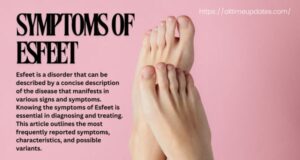
Esfeet is a disorder that can be described by a concise description of the disease that manifests in various signs and symptoms. Knowing the symptoms of Esfeet is essential in diagnosing and treating. This article outlines the most frequently reported symptoms, characteristics, and possible variants.
Symptom 1
- The location: Please describe where the symptom is most commonly observed in the body.
- Severity: Describe how severe this condition can be and the factors that could affect the severity of this symptom.
- Variations: Describe any variation in how the symptoms can manifest in different patients.
Symptom 2
- Place: Name the area that is affected. Area (s) of your body.
- Intensity: Talk about the severity of the symptoms and possible effects on your daily routine.
- Variations: Discuss any differences in the appearance of symptoms based on your patients’ demographics, such as gender, age, or any health issues.
Symptom 3
- Localization: Define the primary and secondary areas that are affected.
- Severity: Describe the range of severity, from moderate to extreme, and what it means for the patient’s health.
- Variations:The symptoms may be different in various ways. Highlight how this condition could be presented differently in multiple situations or phases of the disease.
Symptom 4
- Place: Mark the area of your body that is affected.
- Severity: Define the degree of pain or impairment that results from the symptom.
- Variations: Share information about the most well-known variations and lesser-known forms.
Visual Depiction Of Symptoms
Aids to understanding can help us visualize the physical symptoms of effects. Here are some descriptions of images of typical symptoms seen by patients. Note: The photos must be obtained and added per ethical medical guidelines.[Note: Images must be sourced and included by medical ethics guidelines..
Diagnosis Of Esfeet
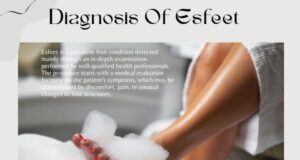
Esfeet is a prevalent foot condition detected mainly through an in-depth examination performed by well-qualified health professionals. The procedure starts with a medical evaluation focusing on the patient’s symptoms, which may be characterized by discomfort, pain, or unusual changes to foot structures.
Role Of Physical Examination And Medical History
Effect identification depends on an extensive physical exam and an extensive medical background. In the physical exam, a medical professional evaluates the anatomy of the foot and its functional alignment. The medical history aids in determining any issues or triggers that could lead to symptoms, such as prior injuries, lifestyle, or workplace hazards.
Potential Imaging Tests
Diagnostic imaging may be recommended. Imaging tests can observe bone alignment and structure, and ultrasound can study soft tissues on the feet.
Importance Of Consulting A Podiatrist Or Healthcare Professional
To get an accurate diagnosis as well as the most appropriate treatment plan for a proper treatment plan, you must seek out a podiatrist or certified health competent. They have specific knowledge and instruments to detect the condition and recommend accurate treatments tailored to the patient’s needs.
Treatment Options For Esfeet
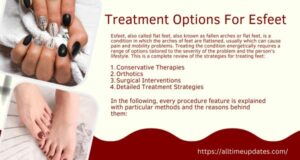
Esfeet, also called flat feet, also known as fallen arches or flat feet, is a condition in which the arches of feet are flattened, usually which can cause pain and mobility problems. Treating the condition energetically requires a range of options tailored to the severity of the problem and the person’s lifestyle. This is a complete review of the strategies for treating feet:
Treatment Options Overview
If you’re dealing with feet issues, it is crucial to consider the various options to determine the most efficient solution. These are the most critical areas:
- Conservative Therapies
- Orthotics
- Surgical Interventions
- Detailed Treatment Strategies
In the following, every procedure feature is explained with particular methods and the reasons behind them:
Conservative Therapies
- Physical Therapy: Aims to strengthen ankle and foot muscles, enhance mobility, and relieve pain.
- Exercises for stretching: Focus on tight heels. This can contribute to flat feet.
- Training for strengthening: Increase ankle and foot stabilization.
- Weight Management: Reducing the pressure on feet as well as reducing pain. It also helps prevent the progression of.
- Suitable footwear: Shoes that provide an arch that is well supported and an elongated sole may benefit from distributing the pressure.
Orthotics
- Custom Orthotics are specifically designed components worn inside shoes that support the arches and evenly distribute pressure.
- Over-the-counter vs. Custom-made options: These are readily available and affordable as custom-made orthotics are made to fit the foot’s shape to provide more assistance.
- Arch Supports: They can be put into shoes to grant extra support for the arch.
Surgical Interventions
- Tendon Repair Surgery: Corrects issues with the tendons supporting the arch.
- Osteotomy: Involves cutting and shaping bone in the foot to warrant proper alignment.
- Arthrodesis: Brings bones from the feet together to create a sturdy arch.
- HyproCure Surgery: HyProCure Surgery involves implanting an intramedullary stent between the heel and ankle bone. Arches need support and stabilization.
Detailed Treatment Strategies
- Conservative Therapy is safe and without risk; its efficacy depends on an individual’s willingness to adhere to the treatment plan.
- Orthotics are highly efficient for enough people; however, pain or improper alignment can pose a problem that requires adjustment.
- Surgery Provides permanent solutions; however, it carries more risk, including infection, nerve damage, or the failure of the bone to heal correctly.
Importance of Professional Guidance
An orthopaedic surgeon or podiatrist can customize your treatment plan. They will recommend the best treatment based on your specific needs and ailments.
If you take the time to consider each choice and consult with a specialist, people who suffer from feet may find substantial relief and improve their quality of life.
Prevention Of Esfeet
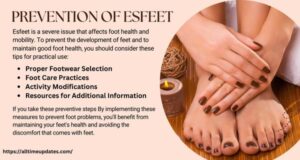
Esfeet is a severe issue that affects foot health and mobility. To prevent the development of feet and to maintain good foot health, you should consider these tips for practical use:
Proper Footwear Selection
- Select the correct size: Make sure that your shoes are comfortable and fit well. Tight or loose shoes may cause foot pain.
- Comfortable Shoes: When selecting new footwear for running or hiking activities, ensure the shoe provides arch support and cushioning.
- Shoe Fitting: Running or hiking boots may be more suited than standard athletic footwear for optimal results.
Foot Care Practices
- Look for signs of injury: infection, or any unusual changes on your feet, such as redness. Doing this regularly will give you peace of mind that anything untoward will occur quickly.
- Dry and clean your feet: To prevent infections, wash and dry your feet daily.
- Moisturize: regularly to protect and hydrate the feet from dryness and flaking and ensure the highest comfort level.
Activity Modifications
- Avoid high-impact activities: Avoid activities that strain your feet. Performing high-impact sports and sitting for prolonged periods could aggravate foot conditions.
- Exercise low-impact: Choose activities with little impact, such as cycling and swimming, to reduce foot stress.
- Foot Stretch: Regular foot stretch exercises increase flexibility and lessen ligament and muscle tension.
Resources for Additional Information
- A podiatrist: See a podiatrist for personalized advice and evaluations of feet. You should consult the podiatrist.
- Educational websites: APMA (American Podiatric Medical Association) sites offer more information about foot health.
- Workshops and seminars: Participate in local foot health and injury prevention seminars.
If you take these preventive steps By implementing these measures to prevent foot problems, you’ll benefit from maintaining your feet’s health and avoiding the discomfort that comes with feet.
Conclusion
In this blog, we explored the intricate details of feet, investigating their causes, signs, and possible treatments. Knowing the many elements leading to this condition and the effectiveness of various treatments offered was essential. Even though there are many home solutions and preventive steps to ease the discomfort, seeking medical professionals to get a correct diagnosis and a customized treatment plan is essential.
Your health must always be at the top of your mind. If you think you may suffer from signs of sleet or have doubts about your foot health and wellbeing, getting well-qualified health advice from a doctor is vital. Make sure you reach out to a doctor who will add patients with excellent medical treatment available.
We invite you to interact with us, ask questions, discuss your thoughts, or subscribe to our newsletters for more exciting material. Your participation enriches the community and allows us to serve you better. Get involved today and stay current!

